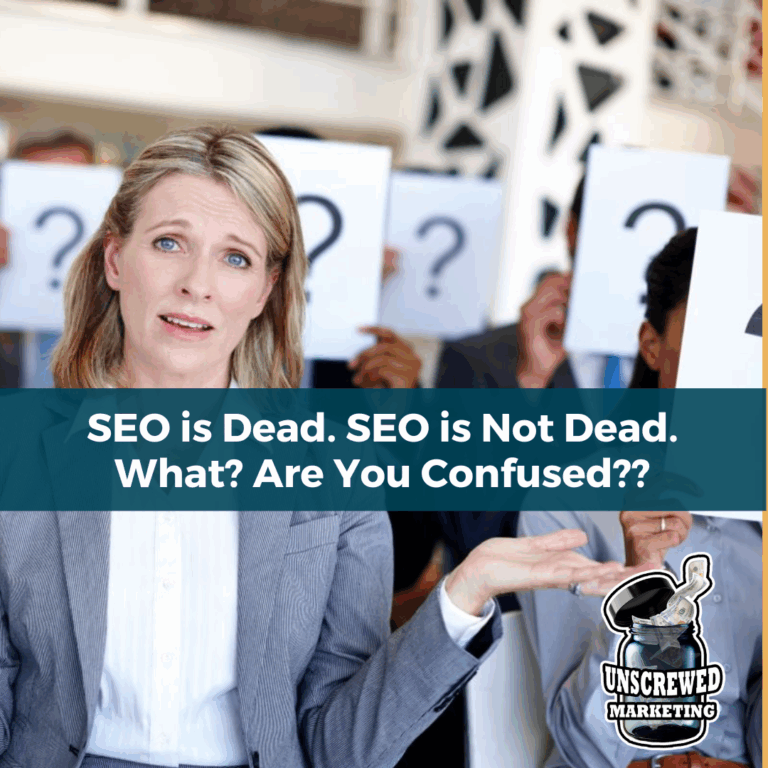- +1 512-591-8295
- [email protected]
- Mon - Fri: 9:00 - 16:00
- +1 512-591-8295
- [email protected]
- Mon - Fri: 9:00 - 16:00
Use code MOM50 at checkout thru Mother’s Day to get 50% off any gift card for marketing services

Do you still need to be doing SEO? You’ve probably heard it before: “SEO is dead.”
That’s not wrong, sort of, but it’s definitely incomplete.
SEO as most people know it should be dead. Keyword cramming, outdated backlink chasing, and optimizing only for Google’s homepage? That playbook stopped working years ago.
The SEO game has changed. The entire field has changed. That playing field you used to visit has been torn down and it’s moved across town, and if you’re showing up in the old spot you’ll never even get on the field.
If you’re still trying to “rank on Google” with nothing more than a few blog posts and a plugin, you’re missing what’s actually happening.
In 2025, your customers are searching everywhere. And they’re getting their answers directly from AI.
As you know if you’ve ever connected with me, my goal is to always help entrepreneurs cut through confusion (and any BS). Here’s the real deal about the current state of SEO.
SEO has evolved over the years (decades). A lot.
We’ve gone from optimizing single keywords… To long-tail keyword phrases… To questions, full-sentence queries, and AI-assisted answer snippets.
We’ve moved from “what are people typing into Google?” to “how are people trying to solve their problem and where are they looking?”
And yet, too many entrepreneurs are stuck on outdated tactics that haven’t worked since before TikTok even existed (in 2016, and it’s predecessor Musical.ly in 2014) . If your SEO strategy starts with “keyword research” and ends with a list of keywords, that’s probably why it isn’t working. And let’s be real: it hasn’t been working for a while.
Google’s May 2025 Core Update (launched May 16) has already made big waves. It added AI Overviews to users in over 200 countries and fully activated “AI Mode,” where Gemini-powered results now summarize—and often replace—click-based search altogether.
That means fewer clicks to your website. More direct answers surfaced by AI. And a much bigger gap between what you think your audience sees… and what they actually do.
Every major update like this brings volatility. For our clients whose SEO or website we manage, we always spend the few weeks after a major algorithm change watching traffic and behavior carefully. This isn’t the time to “wait and see”—it’s the time to respond strategically.
And for us? We’ve been through them all. Panda, Penguin, Hummingbird, BERT, Helpful Content, SGE—you name it. This isn’t the first time that we’ve talked about Google SEO updates.
And our clients’ websites? Still standing. Still getting great results. Because we never optimized just for Google.
We’ve always optimized for people and that focus is proven by the results our clients continue to experience.
I’ve been building websites since before WordPress even existed; back in the HTML-only days. When I started working with SEO, Google was still deciding if keywords in white text on a white background were a good idea.
(They were not. That was your daily 2003 flashback. And they especially are NOT now!) One Fakexpert told their followers to hide keywords on their website; she had never done SEO and had just proclaimed herself as an expert offering SEO services that same day.
So we learned early by watching the results: SEO has never been about chasing algorithms. It’s about serving your customer.
That philosophy has carried our clients through every Google shift since. It’s why their traffic doesn’t crash when a new update rolls out. And it’s why their businesses don’t rely on only one traffic source to survive.
Because we don’t treat SEO as a checkbox. We treat it as one gear in a fully integrated system. It has to be.
Search has never been only about Google, even if you thought it was. We talk a lot about Google SEO, because they do tend to be at the forefront of everything related to search and the other search engines would always follow. So by keeping abreast of the changes they wre making in the search landscape, we would also have our clients well positioned on ALL of the search engines.
Today’s buyers are searching in ways that don’t even look like traditional search:
Which means your content doesn’t just need to rank; it needs to resonate.
That’s why we don’t just focus on “traditional” SEO. Instead of focusing on just one narrow marketing tactic, our clients who are seeing the very best results work with us holistically:
We call this Search Everywhere Optimization—and yes, it includes the newer acronym everyone’s tossing around now: Generative Engine Optimization (GEO). Because your visibility today isn’t about where you post. It’s about how you show up when AI tries to explain what you do.
This part’s critical, especially if you’re beyond the beginner stage.
If you’re evaluating your SEO options, or you’re already spending money on marketing, you need to stop thinking about SEO as top-of-funnel awareness alone.
Today’s search requires MOFU and BOFU content strategies that match how real people make decisions.
Here’s what we mean:
What to focus on:
What to create:
And yes: all of this feeds your AI visibility. These are the types of content pieces that show up in Google’s AI Overview, in Gemini summaries, or in ChatGPT responses. That’s not all that it takes, but it’s the baseline you need to have established.
If you’ve been disappointed with SEO lately, it’s probably not because SEO is broken. It’s because you’re still optimizing for a version of the internet that doesn’t exist anymore.
The real question is:
Can your strategy survive without Google rankings?
And just as importantly:
Can it still get visibility with AI pulling the spotlight?
Our answer is yes—when it’s done right.
Let’s find out.
Request a comprehensive SEO Audit today and I’ll show you:
This isn’t about traffic. It’s about traction. Let’s make sure your marketing is still pulling its weight.
Fractional CMO • SEO Strategist • Website Fixer Over 20 Years
With 20+ years of SEO expertise and 30+ in marketing strategy, I bring a rare combination of technical skill, design insight, and business strategy that most SEO agencies can’t touch. I’ve:
But more importantly: I don’t stop at traffic. I dig in, manually review what others skip when they only run an automated report, and treat SEO as an integral part of your holistic marketing ecosystem. Because showing up in search is just the start. What matters is what happens next.

Vicky Wu, CEO
Author
Curious how you can increase your website traffic?
This website uses cookies to ensure you get the best experience on our website. By continuing to use the website, you agree to our use of cookies. We do not share or sell your information. More info